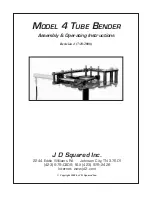
RTC
®
5 PC Interface Board
Rev. 1.9 e
4 Layout and Interfaces
50
innovators for industry
4.4.3 EXTENSION 2 Connector
The 26-pin connector EXTENSION 2 on the RTC
®
5
board (on the RTC
®
4, the corresponding connector is
labeled LASER EXTENSION) provides a buffered 8-bit
digital output port (DATA0 to DATA7). The pins (15)
and (17) must be configured with jumpers.
Jumper Setting
Pins (15) and (17) of the EXTENSION 2 connector
have to be configured via the jumpers
JP2-JP8
on the
back side of the RTC
®
most significant bit (DATA7) of the 8-bit output value
can be assigned to pin (15) or to pin (17). Alterna-
tively, each of the two pins can be set permanently to
+5 V (HIGH) or to GND (LOW level). Alternatively,
pin (17) can be configured for the LATCH signal (see
below) by closing the correspondingly labeled jumper
(see
).
Examples:
• If the DATA7 bit is assigned to pin (15), the full
8-bit output value is available on the output port
(odd numbered pins (1) to (15) of the
EXTENSION 2 connector).
• Setting pin (15) permanently to HIGH results in an
offset of 128 for the output value and restricts
the output value range to (128 … 255).
• Setting pin (15) to LOW restricts the output value
range to 0 … 127.
• The DATA7 bit can be used for other purposes by
assigning it to pin (17).
Laser Signals
Like the laser signals of the LASER connector, the
output signals LASER1 and LASER2 depend on the
selected laser control mode (see
) and are referenced to GND2. If the RTC
®
5 is
equipped with optional optocouplers, then GND2
and the laser output signals will be galvanically
decoupled from PC GND. Otherwise, GND2 are GND
identical (see
chapter 2.3 "Optional Functionality",
8-Bit Digital Output Port
The buffered 8-bit digital output port (TTL level) is
intended for YAG lasers with a digital lamp current
control. However, it can be used for any other
purpose as well. The output is in high-impedance
mode (tri-state) until an initial value is assigned to it.
For programming the output see
The most significant bit (MSB) (DATA7) of the output
value can be used for other purposes, e.g. for
controlling a shutter. To do this, the MSB can be
assigned to an extra pin on the EXTENSION 2
connector (see above).
Via an appropriate jumper setting (see above),
Pin (17) can output a LATCH signal. The RTC
®
5 will
automatically generate the LATCH signal (a 5
µ
s
pulse, active-high) when the value at the 8-bit digital
output port changes. If several bits are simulta-
neously transferred as a data word (i.e. if the bits are
not transferred independently from each other) via
the 8-bit digital output port, then the LATCH signal
should be used for synchronization of data trans-
mission (for example, as a trigger signal for the laser
to assume a different lamp current). The value at the
8-bit digital output port should be read-out with the
rising edge of the LATCH signal, which is generated
5
µ
s after the value change at the 8-bit digital output
port (also see
The LATCH signal is referenced to PC ground (GND).
The maximum current load is 10 mA.
17
(LSB) DATA0 (1)
DATA1 (3)
DATA2 (5)
DATA3 (7)
DATA4 (9)
DATA5 (11)
DATA6 (13)
+5 V / DATA7 / GND* (15)
+5 V/DATA7/GND/LATCH* (17)
LASER2 (19)
(20)
(21)
GND2 (23)
+5 V (25)
(2) GND
(4) NOT CONN.
(6) +5 V
(8) NOT CONN.
(10) NOT CONN.
(12) NOT CONN.
(14) NOT CONN.
(16) NOT CONN.
(18) +5 V
(20)
(21)
(22) LASER1
(24) NOT CONN.
(26) NOT CONN.
Pin-out of the on-board EXTENSION 2 connector
* depends on jumper settings
















































